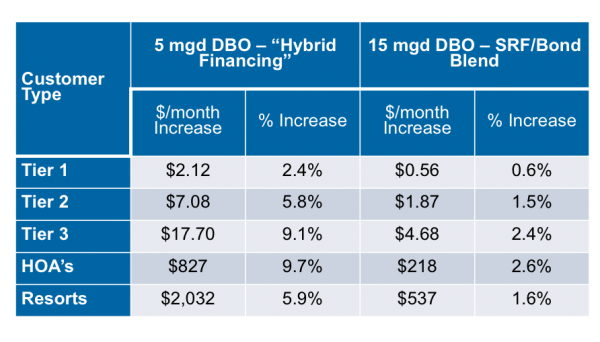By Cassandra Reinhart, Special to the Independent

The South Coast Water District voted to take another step towards building a $100 million plant that converts ocean water into drinking water for its customers by 2021.
The five-acre Doheny desalination plant is proposed for district-owned land alongside San Juan Creek in Dana Point. It could initially produce up to 5 million gallons of water per day, providing 75 percent of district needs within five years. Eventually, the plant could yield 15 million gallons of water per day.
“I am really confident this board can deliver ocean desal to our South Coast customers, as well as making a major commitment to our water reliability,” Bill Green, a water district board vice president, said at a public hearing this past Wednesday, Nov. 15.
The district distributes water to 35,000 customers in South Laguna, Dana Point, and portions of San Clemente and San Juan Capistrano as well as over 2 million visitors per year. Currently, 85 percent of the district’s potable water is supplied from Northern California and the Colorado River through the Municipal Water District of Orange County. Its customers use 5,100 acre-feet per year, which is projected to cost $6.3 million by 2020.
If the Doheny plant produced 5 million gallons of water per day, it would supplant the district’s current use and cost about $1.14 million more annually to produce than imported water, said Rick Shintaku, the district’s chief engineer.
Boosting water production to 15 million gallons per day from the future plant and reselling surplus water would decrease production costs, he said.
The board voted unanimously Wednesday to pursue plans for a district-owned facility and explore financing options using state funds, and a potential $10 million state grant.
Though the vote was unanimous, board member Dennis Erdman stressed weighing all options.
“It’s not a question of whether we need to do this today, or tomorrow, because we do have a reliable source of water,” Erdman said. “But there is a long term reliability issue we haven’t talked about here.”
Full district ownership of the project would mean lower water costs to customers, but carries more risk for the district and less flexibility for funding. Selling water to other public entities would be key to cost control, board members said.
For instance, the Santa Margarita Water District could potentially invest in the project or become a customer. Board member Sandra Jacobs, who attended Wednesday’s meeting, said, “We haven’t formally signed up yet to invest in Doheny, but we are open to flexibility. We’d like to put desal back on the table,” she said.
“South County is 90-percent reliant on imported water,” Dana Point resident Susan Hinman told the board. “I think that is a critical issue. We must have a future water resource that’s local and that will ensure our future security in South County.”
A district-owned plant with a 5-million gallon per day capacity would add from $1.50 to $13 monthly to a residential customer bill, while a 15-million gallon per day plant would increase typical residential bills from 50 cents to $5 per month, a district report shows.
Board members cited a survey where nearly 80 percent of customers were willing to pay higher rates for more reliability, or up to $5 more per month.
“I believe we can deliver 15 million gallons a day through the hybrid financing, ensuring cost control, water quality and water supply for nearly the same monthly payment,” Green said. “It just depends if we have other districts that will share in that.”
Using reverse osmosis, the plant would filter ocean water into drinking water by removing salt. The resulting leftover brine would be sent to the nearby South Orange County Wastewater Authority outfall pipeline, mixed with treated wastewater and discharged into the ocean over two miles off the coast.
Unlike some desalination facilities, the Doheny plant would use slant wells, which draw water from beneath the ocean floor instead of its surface. Slant wells are preferred to better protect marine life. A plant energy recovery system is also envisioned, possibly lowering energy use and costs by as much as 55 percent, district engineers said.
A study shows potential for on-site power generation, said Mark Donovan, project manager and engineer for GHD, Inc., an engineering firm working with SCWD on the project.
The Doheny project isn’t the only one on the table in Orange County. Since 2006, privately owned Poseidon Water has pursued approval of a $1 billion desalination facility in Huntington Beach that would produce up to 50 million gallons of water per day.
Opponents of Poseidon’s venture say it is too expensive and has potential to harm ocean life.
Poseidon disagrees with claims from opponents that the plant will add “thousands” to resident’s yearly water bills.
“If the historical rate of imported water escalation is assumed for the next 30 years, purchasing the desalinated water would indeed result in significant savings,” says a statement on the company’s website.
A Poseidon desalination in Carlsbad has produced over 22 billion gallons of drinking water since December 2015.
The $1 billion project resulted from a 30-year, public-private partnership between Poseidon and the local water authority to meet water needs for 400,000 people. Poseidon’s website says the plant costs typical homeowners an additional $5 per month.
If the Doheny project stays on track, it could be operational by 2021.
“Water is obviously one of those things a lot of people take for granted,” said board member Rick Erkeneff.





[…] Laguna Beach Indy: District Presses on With Desalination […]
[…] Source link […]
[…] SCWD board voted in November to explore financing options for the plant, including a $10 million state grant. Earlier this […]